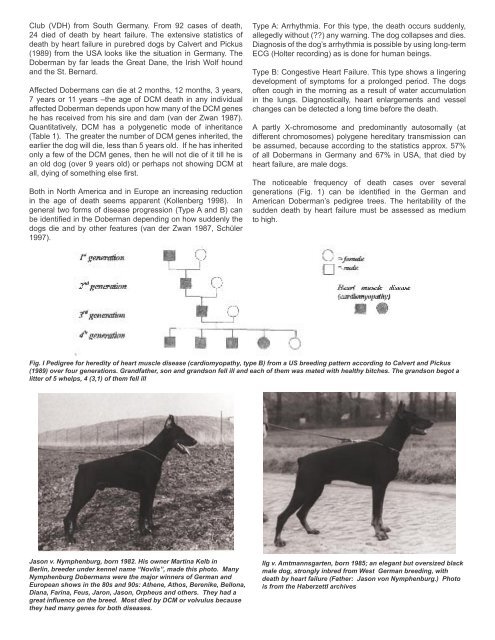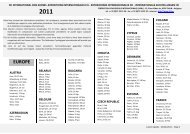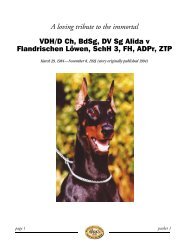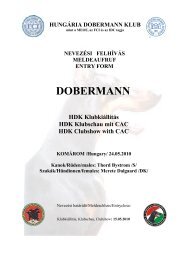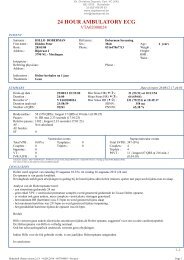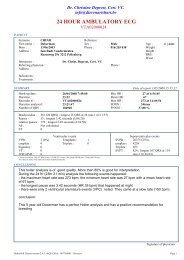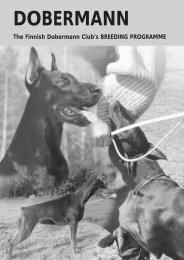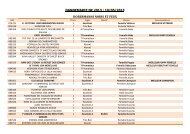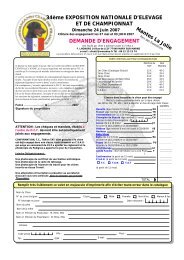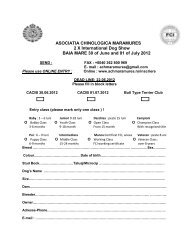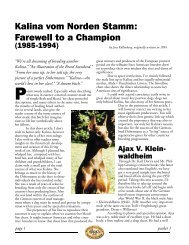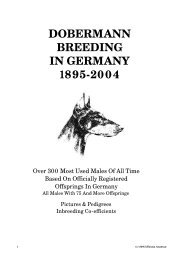Increasing Hereditary Health Problems in the Breeding of Purebred ...
Increasing Hereditary Health Problems in the Breeding of Purebred ...
Increasing Hereditary Health Problems in the Breeding of Purebred ...
- No tags were found...
You also want an ePaper? Increase the reach of your titles
YUMPU automatically turns print PDFs into web optimized ePapers that Google loves.
Club (VDH) from South Germany. From 92 cases <strong>of</strong> death,24 died <strong>of</strong> death by heart failure. The extensive statistics <strong>of</strong>death by heart failure <strong>in</strong> purebred dogs by Calvert and Pickus(1989) from <strong>the</strong> USA looks like <strong>the</strong> situation <strong>in</strong> Germany. TheDoberman by far leads <strong>the</strong> Great Dane, <strong>the</strong> Irish Wolf houndand <strong>the</strong> St. Bernard.Affected Dobermans can die at 2 months, 12 months, 3 years,7 years or 11 years –<strong>the</strong> age <strong>of</strong> DCM death <strong>in</strong> any <strong>in</strong>dividualaffected Doberman depends upon how many <strong>of</strong> <strong>the</strong> DCM geneshe has received from his sire and dam (van der Zwan 1987).Quantitatively, DCM has a polygenetic mode <strong>of</strong> <strong>in</strong>heritance(Table 1). The greater <strong>the</strong> number <strong>of</strong> DCM genes <strong>in</strong>herited, <strong>the</strong>earlier <strong>the</strong> dog will die, less than 5 years old. If he has <strong>in</strong>heritedonly a few <strong>of</strong> <strong>the</strong> DCM genes, <strong>the</strong>n he will not die <strong>of</strong> it till he isan old dog (over 9 years old) or perhaps not show<strong>in</strong>g DCM atall, dy<strong>in</strong>g <strong>of</strong> someth<strong>in</strong>g else first.Both <strong>in</strong> North America and <strong>in</strong> Europe an <strong>in</strong>creas<strong>in</strong>g reduction<strong>in</strong> <strong>the</strong> age <strong>of</strong> death seems apparent (Kollenberg 1998). Ingeneral two forms <strong>of</strong> disease progression (Type A and B) canbe identified <strong>in</strong> <strong>the</strong> Doberman depend<strong>in</strong>g on how suddenly <strong>the</strong>dogs die and by o<strong>the</strong>r features (van der Zwan 1987, Schüler1997).Type A: Arrhythmia. For this type, <strong>the</strong> death occurs suddenly,allegedly without (??) any warn<strong>in</strong>g. The dog collapses and dies.Diagnosis <strong>of</strong> <strong>the</strong> dog’s arrhythmia is possible by us<strong>in</strong>g long-termECG (Holter record<strong>in</strong>g) as is done for human be<strong>in</strong>gs.Type B: Congestive Heart Failure. This type shows a l<strong>in</strong>ger<strong>in</strong>gdevelopment <strong>of</strong> symptoms for a prolonged period. The dogs<strong>of</strong>ten cough <strong>in</strong> <strong>the</strong> morn<strong>in</strong>g as a result <strong>of</strong> water accumulation<strong>in</strong> <strong>the</strong> lungs. Diagnostically, heart enlargements and vesselchanges can be detected a long time before <strong>the</strong> death.A partly X-chromosome and predom<strong>in</strong>antly autosomally (atdifferent chromosomes) polygene hereditary transmission canbe assumed, because accord<strong>in</strong>g to <strong>the</strong> statistics approx. 57%<strong>of</strong> all Dobermans <strong>in</strong> Germany and 67% <strong>in</strong> USA, that died byheart failure, are male dogs.The noticeable frequency <strong>of</strong> death cases over severalgenerations (Fig. 1) can be identified <strong>in</strong> <strong>the</strong> German andAmerican Doberman’s pedigree trees. The heritability <strong>of</strong> <strong>the</strong>sudden death by heart failure must be assessed as mediumto high.Fig. I Pedigree for heredity <strong>of</strong> heart muscle disease (cardiomyopathy, type B) from a US breed<strong>in</strong>g pattern accord<strong>in</strong>g to Calvert and Pickus(1989) over four generations. Grandfa<strong>the</strong>r, son and grandson fell ill and each <strong>of</strong> <strong>the</strong>m was mated with healthy bitches. The grandson begot alitter <strong>of</strong> 5 whelps, 4 (3,1) <strong>of</strong> <strong>the</strong>m fell illJason v. Nymphenburg, born 1982. His owner Mart<strong>in</strong>a Kelb <strong>in</strong>Berl<strong>in</strong>, breeder under kennel name “Novlis”, made this photo. ManyNymphenburg Dobermans were <strong>the</strong> major w<strong>in</strong>ners <strong>of</strong> German andEuropean shows <strong>in</strong> <strong>the</strong> 80s and 90s: A<strong>the</strong>ne, Athos, Berenike, Bellona,Diana, Far<strong>in</strong>a, Feus, Jaron, Jason, Orpheus and o<strong>the</strong>rs. They had agreat <strong>in</strong>fluence on <strong>the</strong> breed. Most died by DCM or volvulus because<strong>the</strong>y had many genes for both diseases.Ilg v. Amtmannsgarten, born 1985; an elegant but oversized blackmale dog, strongly <strong>in</strong>bred from West German breed<strong>in</strong>g, withdeath by heart failure (Fa<strong>the</strong>r: Jason von Nymphenburg.) Photois from <strong>the</strong> Haberzettl archives


